Given the current surge of interest in electric vehicle technology, “zero emissions” is a popular product bullet point to tout. Yet, as far as I know, of all transportation fuels, only hydrogen emits no pollutants when it is combusted.
In electric vehicles, batteries must be charged, and that charge electricity is provided by your friendly neighborhood power plant. And at least 30% of these power plants still burn coal.
A recent Stanford University study concluded that the burning of coal to recharge batteries can sometimes result in higher life cycle CO2 emissions than gasoline-powered vehicles when looking at cradle-to-grave emissions. Admittedly, these results were from situations where mostly coal burning power plants were used to recharge batteries. In Washington and the northeastern states, where more electricity is generated by hydro-electric power plants, the situation would be completely different.
The cost of recharging batteries must also be considered. In states where industrial electricity is inexpensive, like Washington, electricity costs less than five cents per kilowatt-hours (KW/hr), and electric vehicles are practical. In states like California, where electricity costs over 10 cents per KW/hr, and the Northeast where industrial electricity costs in excess of 12 cents per KW/hr, the economics just aren’t convincing. In the Northeast, it might cost between $7 and $13 to recharge truck batteries once.
In the long term, batteries can’t be recharged indefinitely. Each time a battery is recharged, it loses a small amount of its total capacity. After four to five years, batteries no longer have sufficient power to do the job for which they were intended. So the cost of replacement batteries must be factored into any economic justification.
I agree that electric vehicles emit zero tailpipe emissions, and that makes them a valuable participant in urban emissions reduction plans. Anyone who has ever been to downtown Rio de Janeiro or Sao Paulo will quickly agree. Brazil legislates that both gasoline and diesel fuel contain approximately 25% sugarcane-based ethanol. It’s actually hard to breathe in those cities. In my mind, urban vehicles will eventually be either electric, gaseous, or gasoline-fueled to minimize tailpipe emissions. Even diesel engines are questionable in very densely populated cities.
Now, many vehicle manufacturers mostly in the automotive space are following Europe’s lead and touting that they won’t build anything other than electric vehicles by a certain date. I presume most of these proclamations are to appease their younger customers. Europe (including Britain) has no large petroleum reserves, and so they must purchase crude oil from other nations. Europe also has a much higher population density than the U.S. For the U.S. to agree with Europe could be shortsighted.
Consider an editorial in Fleet Equipment’s sister publication Engine Builder. Managing Editor Greg Jones wrote that less than 1% of the vehicles on the road today are electric.
“Roughly two-thirds of oil consumption in America is on the roads, and a fair amount of the rest goes into refining gas and diesel. The oil industry is divided about when peak demand could happen, but the amount of available resources are greater than needed, especially if electric vehicles do begin to encroach on gas-power,” Jones wrote. “How many of you have seen electric charging stations while traveling? I’ve seen very few. The infrastructure needed to support a transition away from gas-powered vehicles is still far away.”
We might see significant market penetration in urban areas in our lifetimes, but I just can’t see them as big players outside the city. And, even if electric vehicle sales double every year, it will still be a decade before they represent more than half of the urban vehicle population.














